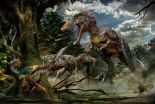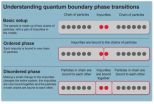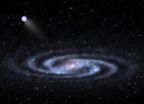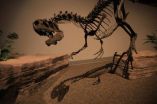(Press-News.org) SAN FRANCISCO -- Changes in tree-ring density in the Arctic may be evidence of changes in light intensity during the trees' growth, according to a new study by San Francisco State University researcher Alexander Stine.
The finding has direct implications for the tree-ring "divergence problem," a phenomenon that has received considerable media attention but has been widely misinterpreted, said Stine, an assistant professor of Earth & climate sciences.
Tree rings consist of a low density ring, which forms early in the growing season, and a high density ring that forms late in the growing season. In colder parts of the world, the dense latewood rings tend to be denser during warm years. Temperature records inferred from Arctic tree rings do a good job of tracking temperature up until the 1960s, but subsequent Arctic tree-ring densities did not keep pace with increases in temperature, a discrepancy that is called the divergence problem.
Climate scientists have been aware of the divergence problem for some time, and it was mentioned in the emails from the Climatic Research Unit at the University of East Anglia, where it became the focus of attention during the 2009 "Climategate" controversy.
The divergence is not a problem for understanding modern climate change in the Arctic, Stine explained, "because we have thermometers and those thermometers tell us it's warming. But it's a problem because if we want to use these tree rings as a proxy for temperatures of the past, we need to make sure that we understand what's happening now."
Stine sees the new findings as the "bright side" of the divergence problem, one which he hopes will lead to a more informed discussion about climate change. "We could learn more about past variations in light intensity at the Earth's surface, and we may be able to deepen our understanding of both trees and climate."
With his colleague Peter Huybers at Harvard University, Stine set out to understand why tree-ring density was declining in the Arctic. One possible explanation, the two thought, might be changes in light intensity that affected the trees' ability to grow. Starting in the 1960s, the amount of sunlight reaching the Earth's surface has declined. Scientists debate the cause of this "global dimming," with many scientists attributing it to pollution particles injected into the atmosphere by human activity that deflect incoming sunlight.
The researchers tested whether global dimming might be responsible for the decline in tree-ring density in the Arctic. This idea had been proposed in the past, but scientists had not been able to test the hypothesis. "It's very hard to distinguish a record that's controlled by temperature from one that's controlled by light, because light and temperature tend to vary together. Sunnier days are usually warmer," Stine added.
To get around this challenge, the researchers took advantage of the fact that there are regional variations in cloud cover and light availability throughout the Arctic, allowing them to compare trees that grew in the brightest and darkest areas but in comparable temperature ranges. They found that divergence was largest in the darkest parts of the Arctic, where changes in light should have the largest effect.
The researchers used changes in tree-ring density following volcanic eruptions to confirm the findings. Major volcanic events such as the 1991 eruption of Mount Pinatubo in the Philippines also have spewed tons of light-scattering sulfur dioxide particles into the atmosphere, decreasing the amount of sunlight reaching the surface.
Their analysis for seven different tree species suggests variations in light intensity caused by volcanic eruptions and global dimming both affect tree-ring density, and this impact is greatest in the darkest Arctic regions. In the brightest areas, the divergence problem essentially disappears, and tree-ring density is most closely linked to temperature instead.
Stine said the findings could have implications for geoengineering proposals that would pump more aerosol particles into the atmosphere as a way to block sunlight and potentially cool a warming planet. The tree-ring study suggests that Arctic trees might not grow as much -- and thus not soak up as much atmosphere-polluting carbon -- under such a plan.
INFORMATION:
The paper "Arctic tree rings as recorders of variations in light availability" was published in the May 7 issue of Nature Communications.
SF State is the only master's-level public university serving the counties of San Francisco, San Mateo and Marin. The University enrolls nearly 30,000 students each year and offers nationally acclaimed programs in a range of fields -- from creative writing, cinema and biology to history, broadcast and electronic communication arts, theatre arts and ethnic studies. The University's more than 219,000 graduates have contributed to the economic, cultural and civic fabric of San Francisco and beyond.
Arctic study sheds light on tree-ring divergence problem
Changes in light intensity may impact density of tree rings, SF State researcher finds
2014-05-07
ELSE PRESS RELEASES FROM THIS DATE:
Newly found dinosaur is long-nosed cousin of Tyrannosaurus rex
2014-05-07
Scientists have discovered a new species of long-snouted tyrannosaur, nicknamed Pinocchio rex, which stalked the Earth more than 66 million years ago.
Researchers say the animal, which belonged to the same dinosaur family as Tyrannosaurus rex, was a fearsome carnivore that lived in Asia during the late Cretaceous period.
The newly found ancient predator looked very different from most other tyrannosaurs. It had an elongated skull and long, narrow teeth compared with the deeper, more powerful jaws and thick teeth of a conventional T. rex.
Palaeontologists were uncertain ...
Melting an entire iceberg with a hot poker: Spotting phase changes triggered by impurities
2014-05-07
"What a curious feeling," says Alice in Lewis Carroll's tale, as she shrinks to a fraction of her size, and everything around her suddenly looks totally unfamiliar. Scientists too have to get used to these curious feelings when they examine matter on tiny scales and at low temperatures: all the behaviour we are used to seeing around us is turned on its head.
In research published today in the journal Nature Communications, UCL scientists have made a startling discovery about a familiar physical effect in this unfamiliar setting.
Phase transitions are a category of ...
Sprites form at plasma irregularities in the lower ionosphere
2014-05-07
Atmospheric sprites have been known for nearly a century, but their origins were a mystery. Now, a team of researchers has evidence that sprites form at plasma irregularities and may be useful in remote sensing of the lower ionosphere.
"We are trying to understand the origins of this phenomenon," said Victor Pasko, professor of electrical engineering, Penn State. "We would like to know how sprites are initiated and how they develop."
Sprites are an optical phenomenon that occur above thunderstorms in the D region of the ionosphere, the area of the atmosphere just above ...
International molecular screening program for metastatic breast cancer AURORA at IMPAKT
2014-05-07
While research has made great strides in recent decades to improve and significantly extend the lives of patients with early breast cancer, the needs of patients with advanced or metastatic disease have largely been ignored. Moreover, despite the fact that the overall breast cancer death rate has dropped steadily over the last decade and significant improvements in survival have been made, metastatic breast cancer represents the leading cause of death among patients with the disease.
In this context the Breast International Group (BIG) recently launched AURORA, which ...
Nearest bright 'hypervelocity star' found
2014-05-07
SALT LAKE CITY, May 7, 2014 – A University of Utah-led team discovered a "hypervelocity star" that is the closest, second-brightest and among the largest of 20 found so far. Speeding at more than 1 million mph, the star may provide clues about the supermassive black hole at the center of our Milky Way and the halo of mysterious "dark matter" surrounding the galaxy, astronomers say.
"The hypervelocity star tells us a lot about our galaxy – especially its center and the dark matter halo," says Zheng Zheng, an assistant professor of physics and astronomy and lead author ...
All teeth and claws? New study sheds light on dinosaur claw function
2014-05-07
Theropod dinosaurs, a group which includes such famous species as Tyrannosaurus rex and Velociraptor, are often regarded as carnivorous and predatory animals, using their sharp teeth and claws to capture and dispatch prey. However, a detailed look at the claws on their forelimbs revealed that the form and shape of theropod claws are highly variable and might also have been used for other tasks.
Inspired by this broad spectrum of claw morphologies, Dr Stephan Lautenschlager from Bristol's School of Earth Sciences studied the differences in claw shape and how these are ...
Revealing the healing of Dino-sores
2014-05-07
Scientists have used state-of-the-art imaging techniques to examine the cracks, fractures and breaks in the bones of a 150 million-year-old predatory dinosaur.
The University of Manchester researchers say their groundbreaking work – using synchrotron-imaging techniques – sheds new light, literally, on the healing process that took place when these magnificent animals were still alive.
The research, published in the Royal Society journal Interface, took advantage of the fact that dinosaur bones occasionally preserve evidence of trauma, sickness and the subsequent signs ...
Study finds pregnant women show increased activity in right side of brain
2014-05-07
Pregnant women show increased activity in the area of the brain related to emotional skills as they prepare to bond with their babies, according to a new study by scientists at Royal Holloway, University of London.
The research, which will be presented at the British Psychological Society's annual conference on Wednesday 7 May, found that pregnant women use the right side of their brain more than new mothers do when they look at faces with emotive expressions.
"Our findings give us a significant insight into the 'baby brain' phenomenon that makes a woman more sensitive ...
Mass vaccination campaigns reduce the substantial burden of yellow fever in Africa
2014-05-07
Yellow fever, an acute viral disease, is estimated to have been responsible for 78,000 deaths in Africa in 2013 according to new research published in PLOS Medicine this week. The research by Neil Ferguson from Imperial College London, UK and colleagues from Imperial College, WHO and other institutions also estimates that recent mass vaccination campaigns against yellow fever have led to a 27% decrease in the burden of yellow fever across Africa in 2013.
Yellow fever is a serious viral disease that affects people living in and visiting tropical regions of Africa and ...
Water from improved sources is not consistently safe
2014-05-07
Although water from improved sources (such as piped water and bore holes) is less likely to contain fecal contamination than water from unimproved sources, improved sources in low- and middle-income countries are not consistently safe, according to a study by US and UK researchers, published in this week's PLOS Medicine.
These findings are important as WHO and UNICEF track progress towards the Millennium Development Goals water target using the indicator "use of an improved source": this study shows that assuming that "improved" water sources are safe greatly overestimates ...
LAST 30 PRESS RELEASES:
Low daily alcohol intake linked to 50% heightened mouth cancer risk in India
American Meteorological Society announces Rick Spinrad as 2026 President-Elect
Biomass-based carbon capture spotlighted in newly released global climate webinar recording
Illuminating invisible nano pollutants: advanced bioimaging tracks the full journey of emerging nanoscale contaminants in living systems
How does age affect recovery from spinal cord injury?
Novel AI tool offers prognosis for patients with head and neck cancer
Fathers’ microplastic exposure tied to their children’s metabolic problems
Research validates laboratory model for studying high-grade serous ovarian cancer
SIR 2026 delivers transformative breakthroughs in minimally invasive medicine to improve patient care
Stem Cell Reports most downloaded papers of 2025 highlight the breadth and impact of stem cell research
Oxford-led study estimates NHS spends around 3% of its primary and secondary care budget on the health impacts of heat and cold in England
A researcher’s long quest leads to a smart composite breakthrough
Urban wild bees act as “microbial sensors” of city health.
New study finds where you live affects recovery after a hip fracture
Forecasting the impact of fully automated vehicle adoption on US road traffic injuries
Alcohol-related hospitalizations from 2016 to 2022
Semaglutide and hospitalizations in patients with obesity and established cardiovascular disease
Researchers ‘listen in’ to embryo-mother interactions during implantation using a culture system replicating the womb lining
How changing your diet could help save the world
How to make AI truly scalable and reliable for real-time traffic assignment?
Beyond fragmented markets: A new framework for efficient and stable ride-pooling
Can shape priors make road perception more reliable for autonomous driving?
AI tracks nearly 100 years of aging research, revealing key trends and gaps
Innovative techniques enable Italy’s first imaging of individual trapped atoms
KIER successfully develops Korea-made “calibration thermoelectric module” for measuring thermoelectric device performance
Diversifying US Midwest farming for stability and resilience
Emphasizing immigrants’ deservingness shifts attitudes
Japanese eels, climate change, and river temperature
Pusan National University researchers discover faster, smarter heat treatment for lightweight magnesium metals
China’s 2024 Gastroenterology Report: marked progress in endoscopy quality and disease management
[Press-News.org] Arctic study sheds light on tree-ring divergence problemChanges in light intensity may impact density of tree rings, SF State researcher finds



